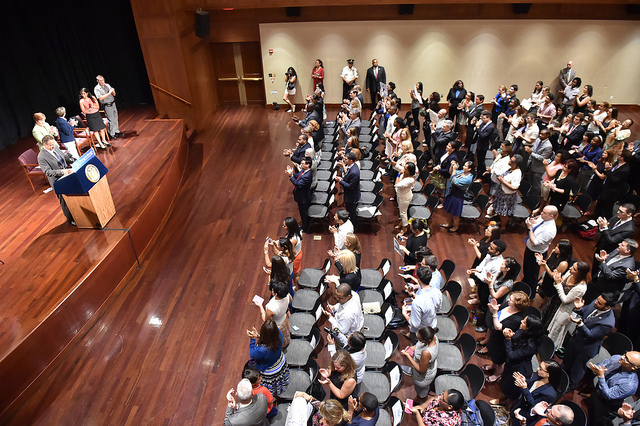
Gov. Cuomo (Office of the Governor - Kevin P. Coughlin)
Governor Cuomo’s leaked plan to make community colleges in New York tuition-free, potentially aligning with President Obama’s America’s College Promise initiative, is an exciting step towards reinvesting in higher education after years of flat-lined funding and tuition hikes. This thinking, if it indeed means increasing our state’s investments in higher education, reflects an awakening around the role that community colleges play in the fabric of society and the future of our economy.
As it currently stands, insufficient state support for higher education in New York is failing students and families. Funding is down seven percent since the Great Recession, and a necessary “Maintenance of Effort” bill passed by the Senate and Assembly forcing the Governor to fund mandatory costs for SUNY and CUNY is on the Governor’s desk with an uncertain future.
What’s more, state support makes up only about a quarter of total community college revenue – leaving students to pay more in tuition, which is among the highest in the country. And at the same time that tuition at our community colleges has increased by $735 over the last 10 years, the Tuition Assistance Program (TAP) - our state’s need-based aid program, not available to part-time students - has only increased by $165 during that same time.
Indeed, increased investment by the state would mark a drastic and much-needed shift from burdening students and families with tuition hikes throughout the Great Recession, and a smart move that would renew our commitment to boosting the take home pay of hard-working New Yorkers.
Average earnings for full-time workers with an associate’s degree are nearly a third higher than earnings for those with only a high school diploma, not to mention that more educated people have additional opportunities to ascend the economic ladder.
But economic prosperity isn’t just good for the workers who are lucky enough to achieve it; it’s good for our state as a whole. It’s estimated that New Yorkers with an associate’s degree will contribute more than $35,000 in state taxes and a New Yorker with a bachelor’s degree will contribute more than $60,000 in state taxes throughout their lifetime. With 330,000 enrollees in the CUNY and SUNY community college system, that means an impressive return on investment.
The President’s initial vision for creating a federal free community college plan is understood to be a first-dollar contribution that pays tuition and fees up front, leaving any remaining federal Pell Grants to cover expenses like textbooks and other living expenses. For context, last year more than 160,000 New York State students received $160 million worth of federal Pell Grants, relying on both state and federal investments to cover not just tuition and other costs of attending school.
A state-federal partnership such as the one described by the Obama Administration (but that has stalled in Congress) could be crafted in a way that gives a federal match encouraging states to invest more and provide first-dollar support, making much-needed increased investment.
If a state pursues a free community college plan poorly, however, it could merely repackage its current investments to cover whatever tuition that the Pell grant (or any other future federal match) does not cover, or to make tuition free but reduce investments in critical need-based aid that help cover the full cost of going to school. That’s a direction that policymakers here should steer clear from.
As we head into the next legislative session in Albany, one thing is clear: we need to act quickly, and not point to the gridlock in Washington as a reason to throw up our hands, say we tried, but ultimately leave New Yorkers further behind.
Even with no additional matching federal dollars forthcoming anytime soon, the governor and other state policymakers can and should lead on this vision around committing new investments to community college students. Governor Cuomo can start with his upcoming executive budget proposal due in late January.
With the governor talking about an initial $500 million investment, and policymakers such as Assemblymember James Skoufis talking about a $2 billion “TuitionFreeNY” bill to provide free tuition to all SUNY and CUNY students, the time has come for New York State to put forward a comprehensive solution to address the needs of the state’s grossly under-resourced community college system and lead the country in creating a universally accessible public higher education opportunity.
In the early 1890s, the Committee of Ten, an elite group of academics and bureaucrats, found that four additional years (what we know as high school) of public education for every American student was necessary. It’s fitting that 125 years later we are having the same conversation to better fit our institutions to the needs of today’s workforce. The additional investment of $500 million, with or without federal matching dollars, is a step towards leading the way in what it means to value and leverage public education in the 21st century.
***
Kevin Stump is the Northeast Director for Young Invincibles (YI), an advocacy and policy organization working on higher education, health, and jobs issues impacting 18-34 year olds. YI is also a part of President Obama's College Promise Task Force. On Twitter @KevinStump and @YoungInvincible.
***
Have an op-ed idea or submission for Gotham Gazette? E-mail editor Ben Max: This email address is being protected from spambots. You need JavaScript enabled to view it.